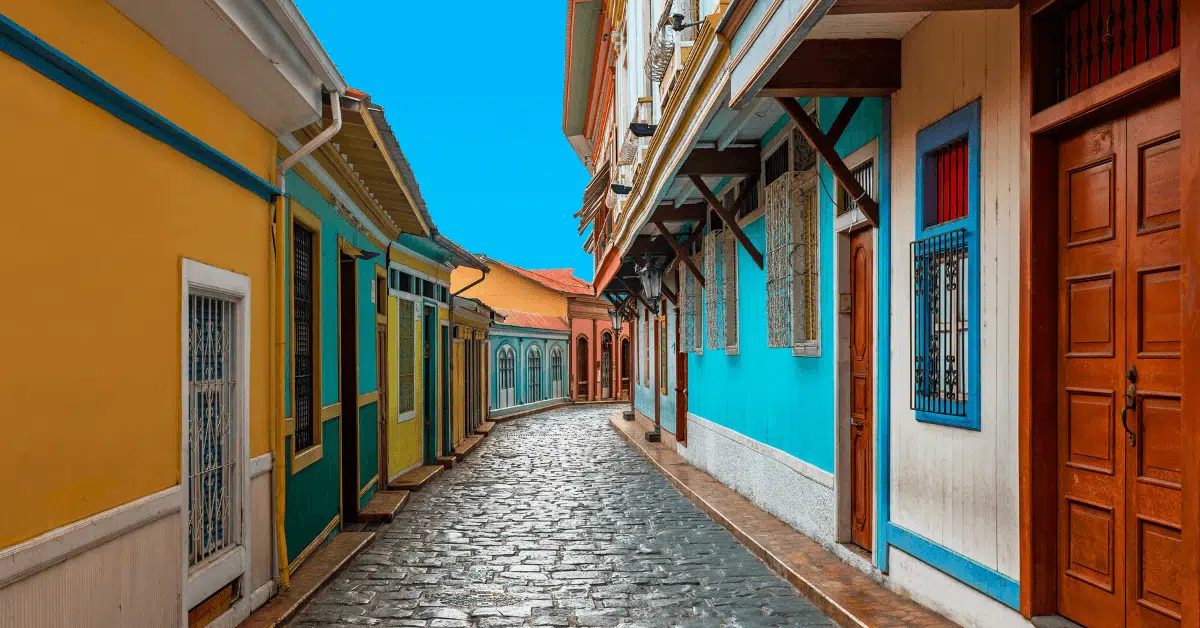Ultimate Ecuador Digital Nomad Guide
If you’re a digital nomad – or want to become one – consider spending time in Ecuador. With a low cost of living, plenty of travel potential, bustling cities, laid-back beach towns, and so much more, it’s a digital nomad paradise that many have yet to explore.
After having lived for over two years in Ecuador (and even finding love while traveling!), I can tell you – it is a mistake to overlook this incredible country, as a travel destination or a place to spend a longer period of time!
Keep reading for all the details you’ll need to know about why and how to set up as a digital nomad in Ecuador. Spending so much time there, I’ve learned all the nitty gritty details, and I’m sharing them here for you first!
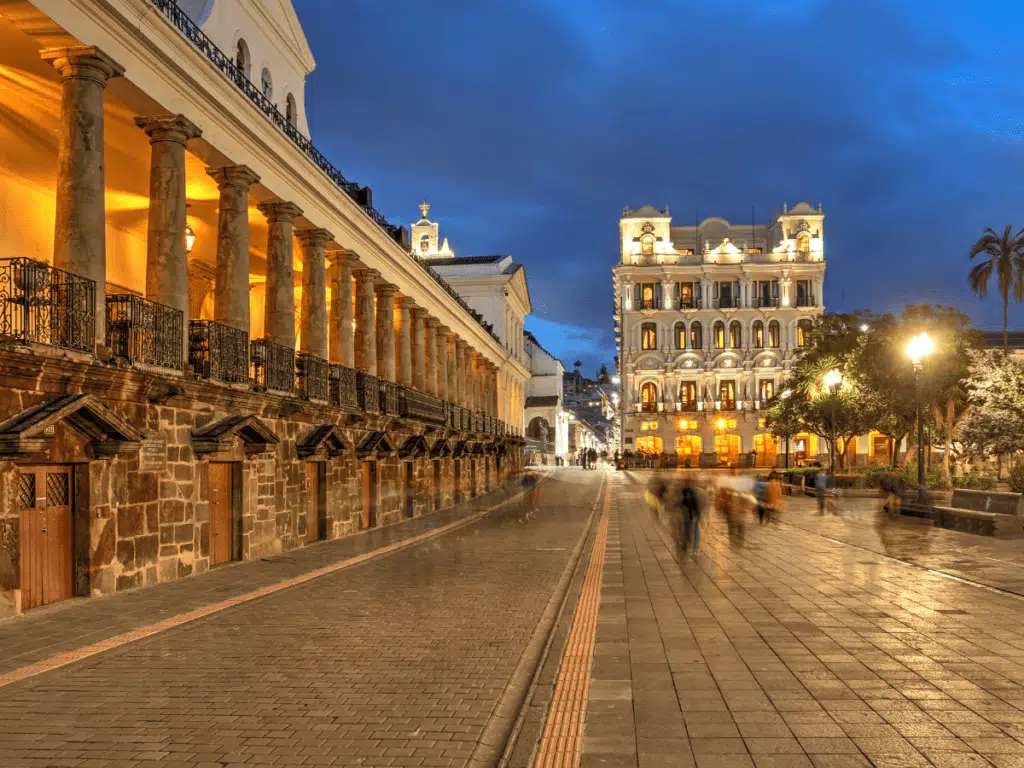
This post contains affiliate links that may reward me monetarily or otherwise when you use them to make qualifying purchases – at no cost to you. As an Amazon Associate, I earn from qualifying purchases. For more information, please read our disclosure policy.
Why Ecuador
Ecuador is a fantastic country with tons to see and do to keep travelers busy and provide for an incredible after-work lifestyle for digital nomads.
Reasons to Choose Ecuador
Awesome Travel Opportunities
Ecuador’s four regions – the Galapagos, the coast, the mountains, and the Amazon are close by no matter where you’re based, making weekend trips inexpensive and easy.
After traveling throughout Ecuador extensively, I think it is one of the most underrated countries for travel I’ve visited.
Adventure Sports & Outdoor Activities
Ecuador is known for its world-class trekking, adventure sports, natural beauty, and biodiversity. There are seriously countless things to do in Ecuador – even after spending two years there, I have a list ready of things I want to do when I’m back.
Bustling Cities
Cities in Ecuador like Quito and Guayaquil, and to a lesser extent, Cuenca, offer a fantastic array of shopping, cultural experiences, restaurants, bars, and nightlife to keep you busy as well. This is great for the traveler, even better for the digital nomad.
Low Cost of Living
The low cost of living in Ecuador – spending under $1000 per month is very doable – has made Ecuador attractive for expats and retirees for years. More on the cost of living in Quito and the cost of living in Cuenca are listed below.
Easy Visa Policy
Ecuador’s easy visa policy lets nearly all visitors get an automatic 90 days tourist visa, with a relatively easy-to-obtain additional 90-day extension. There are several non-immigrant visa options digital nomads could apply for that can help you stay in the country for years if you want to.
Growing Digital Nomad Hub
Bali, Chiang Mai, and even the larger Latin American digital nomad hubs like Mexico City and Medellin, can start to feel insular and even disconnected from local experiences. Ecuador’s smaller digital nomad community makes it easier to branch out.
You’ll find coworking spaces are popular with local small business and start-up owners and host business accelerators as well.
Having local connections and experiences is part of what makes nomad life great to begin with, and it’s easy to enjoy that in Ecuador.
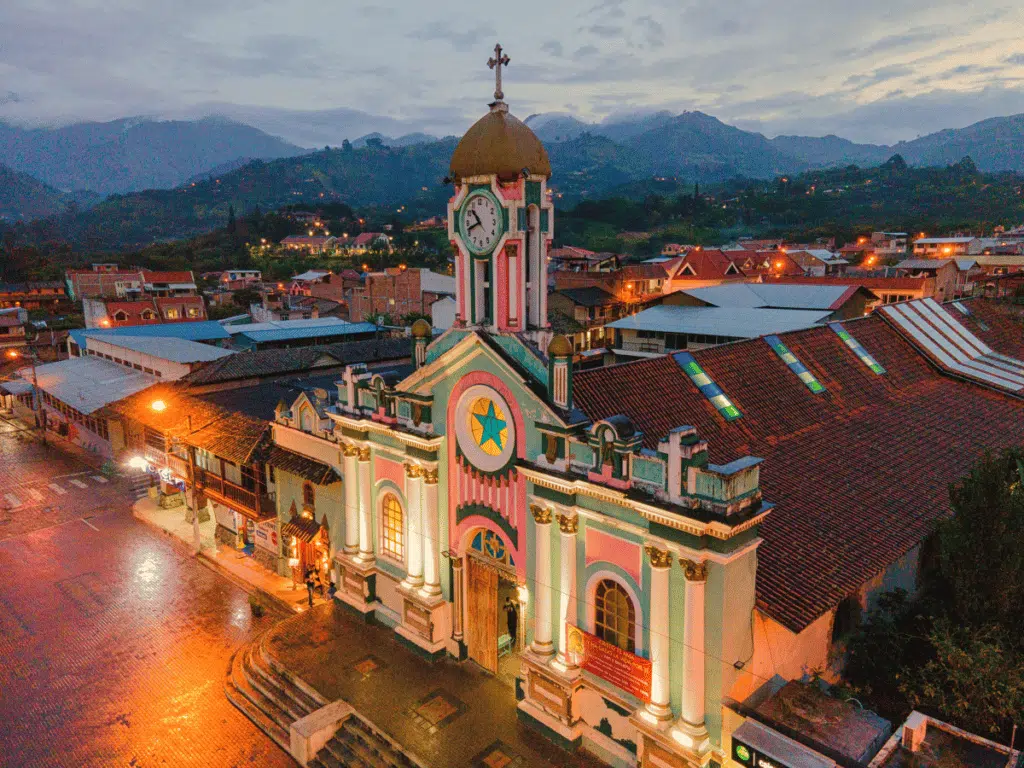
Visas for Ecuador
One of Ecuador’s most attractive features for digital nomads is the country’s generous visa policy for the majority of nationalities – only citizens from a handful of countries need to do anything more than booking a ticket and showing up.
- Upon arrival, visitors are stamped with a 90-day tourist visa (the T-3 visa).
- It’s important to note that these 90 days are not granted per entry into the country but per traveler per YEAR. That means no “visa runs” to other countries to restart your 90-day clock – if you want to stay longer than 90 days over the course of a calendar year, you’ll need to apply to extend your visa.
Your 90 days can be extended to 180 with an application for a 12-IX 180-day non-immigrant visa. You’ll have to apply for this visa in person at one of the nation’s many offices of Servicios de Apoyo Migratorio (Migratory Support Service).
Important: One detail to note is that to EXTEND your 90-day tourist visa, you must show a bank account with at least $2000 to meet the extension’s economic solvency requirement.
Ecuador Digital Nomad Visa
For digital nomads looking to stay in Ecuador for a bit longer, consider Ecuador’s new digital nomad visa. One of just a few dedicated digital nomad visas in the Americas currently, Ecuador’s digital nomad visa has some very attractive features:
- Two years of residency in Ecuador
- A relatively low-income requirement for applicants: $1,275 per month, or just $15,300 per year. Remote income isn’t subject to taxes in Ecuador.
- Online application process (though an in-person interview is required)
You’ll find a detailed guide for applying for the visa online, including a helpful video showing exactly how to apply online, submit documents, and follow through the steps of the process. While the visa is still quite new, it looks like a fabulous option for those looking to take advantage of all that Ecuador has to offer digital nomads.
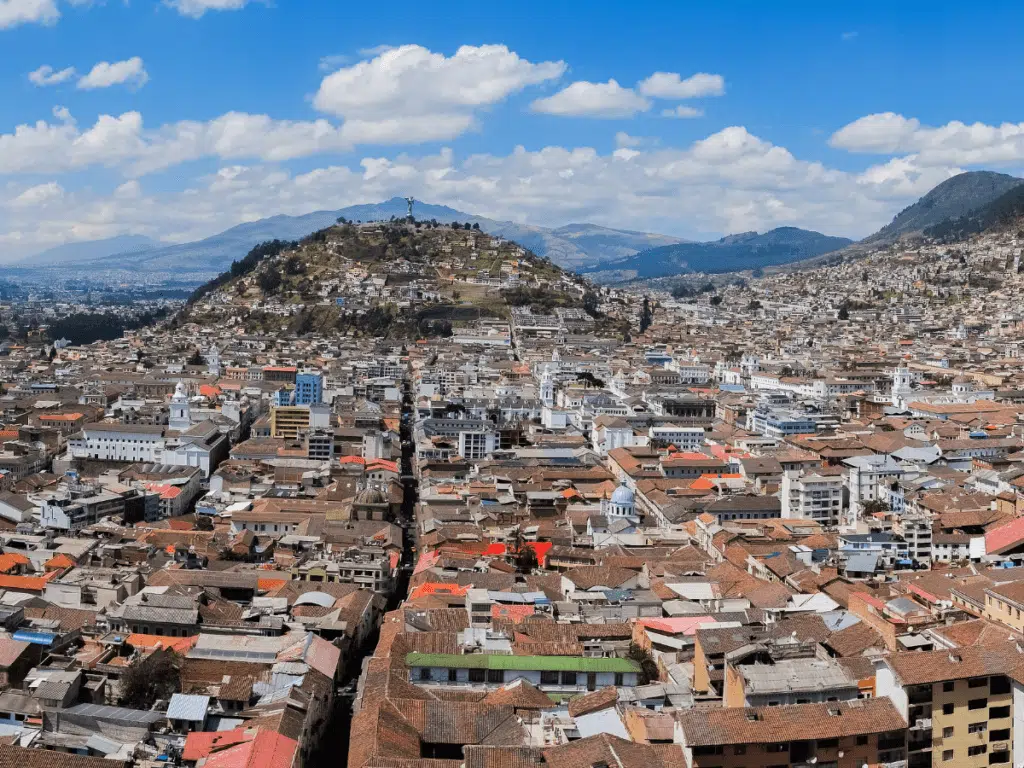
Cost of Living in Ecuador
The cost of living in Ecuador has been an attractive factor for expats and retirees from around the world for years, as it is quite easy to live comfortably for a low cost. Ecuador uses the US dollar as its official currency, but prices for most things are much, much lower than they are in the United States.
The cost of living in Ecuador generally ranges from $650-1200 USD per month.
Check out the cost of living in Quito and the cost of living in Cuenca – listed and explained below – for more extensive breakdowns in each of these digital nomad hubs.
My husband and I spent around $700-900 a month for the two of us, combined. We had a two-bedroom apartment with floor-to-ceiling windows in a fantastic, central area of town, and we traveled around Ecuador when we wanted.
Now, we budgeted quite carefully and chose to live simply to keep that budget low: we lived in a suburb of Quito rather than in the very center of the city.
We also spent two years in Ecuador, which meant we had a longer rent contract in an unfurnished apartment – less expensive month to month but with a higher upfront cost for furnishing. But, it is doable to live extremely cheaply in Ecuador and still live very comfortably.
Weather in Ecuador
Ecuador has a really nice, moderate temperature year-round, making it a fantastic spot for those looking to escape cold winters.
Given its location on the equator, the country only experiences a rainy season and a dry season, and an ideal warm temperature throughout the year. However, weather can vary a lot from region to region in the country.
The Highlands – The Andes
Dry season in the mountains and highlands in cities like Quito and Cuenca is from June – September, with the wettest months of the rainy season from December – March.
During the rainy season, you can expect a strong afternoon rainy for an hour or so, and the rest of the day will be sunny and pleasant. Expect spring-like weather year-round, that can get hot in the sun and cold in the evening.
The Coast
Coastal cities like Guayaquil and Ecuador’s incredible beaches experience a tropical climate year-round, with less of a defined rainy and dry season than you’ll find in the mountains.
Average temperatures sit around 78°F / 26°C throughout the year, with the hottest months from February through April.
The Amazon
The eastern part of the country, dominated by the Amazon rainforest tends to be at least sporadically rainy – no surprise – most of the year. It is hot year-round, and sporadically rainy with an average temperature of around 78°F / 26°C.
August through September and December through March tend to have periods of drier weather.
The Galapagos
The Galapagos are warmer and wetter from December through June. The islands mimic the dry season of the highlands from June through September and tend to be cooler and drier from July through November.
Read More: 10 Best Things To Do in the Galapagos Islands
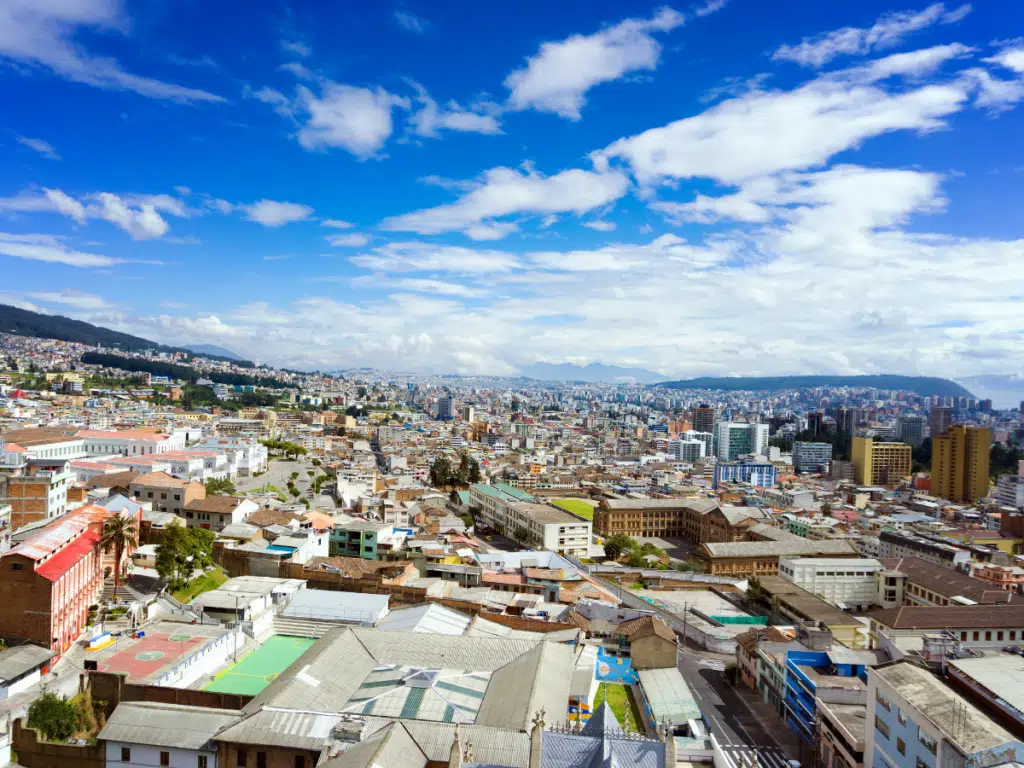
What To Pack for Ecuador
Check out our Ultimate Ecuador Packing List to help you pack for your trip – we’re sharing exactly what to bring to Ecuador and what we never travel without.
Digital Nomad Hubs in Ecuador
Ecuador has a number of larger cities in which digital nomad communities have begun to spring up as coworking spaces have exploded across the country in the last 5 years.
Ecuador’s digital nomads generally head to Quito and Cuenca, both large cities in the mountains, and to a smaller number in cities like Guayaquil, Ecuador’s largest city, located on the coast.
However, internet throughout the country is now generally quite good, opening up many smaller communities as places that digital nomads may want to visit.
Cities and towns that are favorites with travelers, like Mindo, Montañita, Baños, and others, would make for fun excursions for digital nomads based in larger cities, or as longer-term places to stay for those looking to live outside a major city.
Quito, Ecuador
I called Quito home for two years, and really, really enjoyed it. I would love to spend an extended period of time there again soon, and still think of all the things I miss from Quito.
If you’re thinking about coming to Ecuador as a digital nomad, or looking into options for digital nomad life in Latin America, I highly recommend considering Quito.
Best Hotels & Hostels in Quito
- The Secret Garden, Quito ($)
- Selina Quito ($ – $$)
- Vista del Angel Boutique Hotel ($$)
- Hotel Carlota ($$ – $$$)
- Casa Gangotena ($$$)
Best Parts of Living in Quito
Big City Amenities
There isn’t much you won’t be able to find in Quito, and there is plenty to do at all times. There are plenty of restaurants and cafes of all types to check out, along with a decent-sized nightlife scene with bars and clubs. Even the craft beer scene (check out Bandido Brewing!) is growing here.
Quito has tons of art and cultural events to keep you busy – I always loved the low-cost film festivals at the Casa de la Cultura and the many places throughout the city you can hear live music or attend parades and cultural events to learn more about Ecuador.
Digital Nomads and Expats
There is a growing number of digital nomads in Quito, as well as expats that are based more permanently here, meaning it isn’t hard to make community here with other like-minded foreigners.
There has been an explosion of coworking spots opening in Quito to cater to this population, as well as plenty of trendy cafes with internet and delicious snacks to work from as well.
Good Public Transportation
The public transportation system in Quito, though not perfect, is extensive and quite inexpensive. Bus lines run frequently and select bus and trolley lines throughout the city have separate lanes to avoid traffic.
Taxis are also plentiful and inexpensive, but make sure you ask the driver to turn on the meter. Ridesharing apps are growing in popularity as well.
Quito is Beautiful
One of Quito’s attractions, something that still makes an impression on me, is just how beautiful the city is.
Beyond having the largest and best-preserved colonial historic center in Latin America, the city is nestled in a valley between towering volcanos and mountains, meaning you’ll have a fantastic view from every corner. It’s a refreshing way to look up from your computer and see.
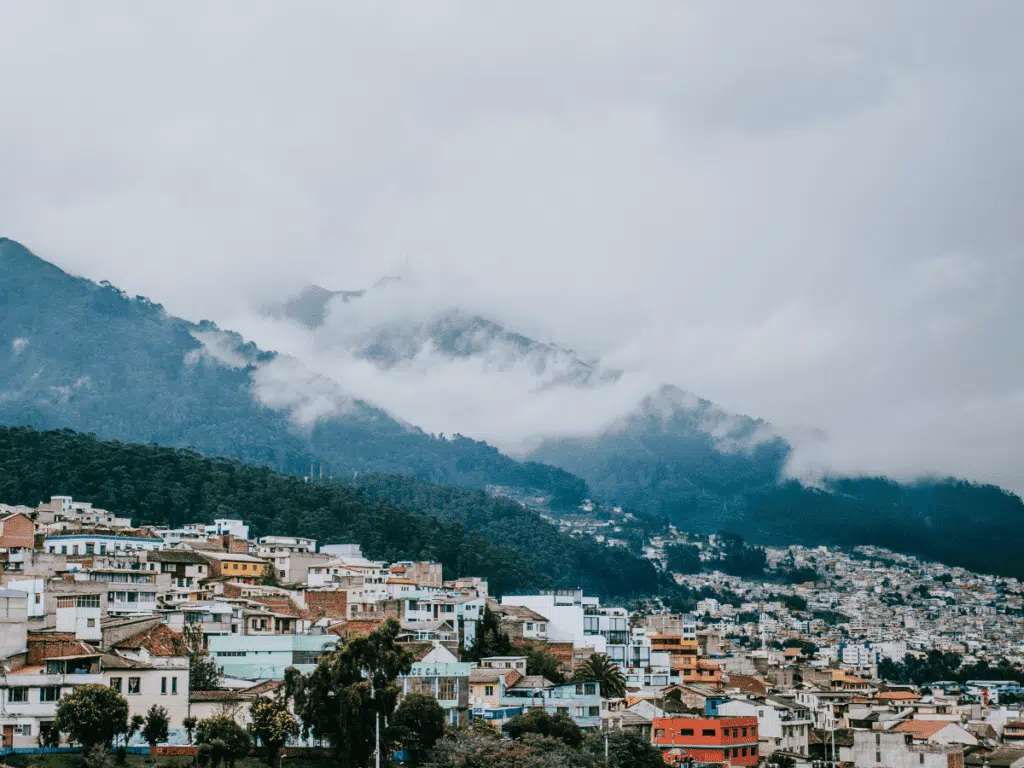
Travel Essential
Don’t head out on your adventure without comprehensive travel insurance! Good travel insurance may cover lost or stolen gear, medical emergencies, delayed or canceled flights, and more. Check out the policies available from SafetyWing or compare plans using Visitors Coverage.
Worst Parts of Living in Quito
Petty Crime
Quito isn’t an unsafe city at all, but I’d say it’s a place where you need to take precautions to avoid petty crime like pickpocketing.
I didn’t experience pickpocketing personally, even after two years of living there, nor did I have any close calls, but I had several friends who were pickpocketed.
Thankfully, with a good awareness and being proactive to keep your things safe, you should have no problem in Quito overall.
Sudden Weather Changes
Weather in Quito is generally quite good, with year-round springtime weather, but the weather can sometimes get downright crazy, especially with bursts of rainy during the rainy season months of December through April.
Even during the rainy season, mornings are generally sunny and pleasant, but afternoon downpours strengthened by the mountains can catch you by surprise and totally transform the day.
It can get downright cold in Quito in the evening and at night, making a long sleeve and a sweater necessary, which is definitely something to keep in mind for those escaping winters.
Cost of Living in Quito
Cost of living in Quito can vary greatly depending on where in the city you choose to live and how comfortable you want to be. There are new, luxury condos that are over $1000 per month, and there are rooms and small apartments for rent for $200 or less.
A digital nomad can live comfortably for $650-1000 per month.
I mentioned above that when my husband and I lived in Quito, we spent under $1000 combined – this is possible too!
We lived quite frugally and lived in a suburban area of the city (the Valle de los Chillos) – our $225 two-bedroom apartment with floor-to-ceiling windows would have easily cost $600 in the middle of Quito.
Here are some typical monthly costs in Quito to consider:
– Rent: $350-700
– Coworking: $60-125
– Transportation: $30-40
– Groceries: $90-120
– Eating Out / Nightlife: $30-100
Coworking in Quito
Quito has a large number of coworking spaces throughout the city with prices for everyone’s budget. Here are some of the best that I recommend checking out.
Play House
PLAY House is a fantastic coworking option in the La Floresta neighborhood, an artsy and beautiful neighborhood in the city near transportation and with plenty to see and do. There is a marked effort to help digital nomads get connected, but the space offers enough privacy to let you be productive as well.
Monthly plans start at $45 for 100 hours or $80 for full-time use.
PLAY House also offers some inexpensive co-living options on-site for those looking for an inexpensive living arrangement in Quito. A private room with a private bathroom and terrace costs $300 per month, with shared kitchen and laundry options.
There are also less expensive private and shared co-living spaces available.
Impaqto
Impaqto is one of Quito’s best coworking groups. It is home to plenty of digital nomads, as well as local business owners and start-ups that have embraced the use of the space.
There are four locations in Quito to choose from (La Floresta, La Carolina, the business district, and in a neighboring valley of Cumbayá), and one in Cuenca, which we also recommend! Monthly plans start at $100 and for just $15 more a month you can use any of their locations.
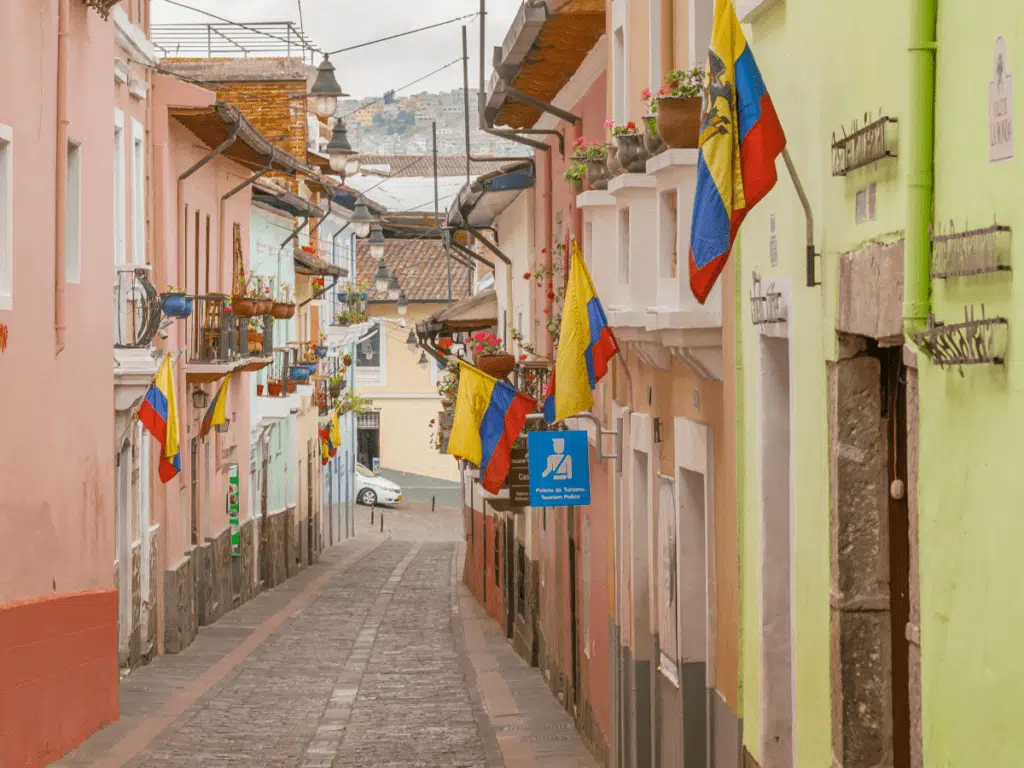
Coworking ConQuito
The Coworking ConQuito is a beautiful space with a lot of opportunities to connect with other digital nomads. Its space hosts lots of TedX events and other networking and socializing events for those looking to connect with other digital nomads here.
Monthly plans start at only $39. While not located in one of the most central neighborhoods, it is a great and inexpensive option for digital nomads.
Quito Transportation
Local Transportation
Buses in Quito are plentiful, extremely cheap ($0.25 or a few cents more), and can take you wherever you need to go. There are three bus routes in Quito with dedicated lanes that (mostly) help them avoid traffic, making them the most convenient transportation options – the Trolebus, EcoVia, and Metrobus.
Other routes zig-zag across the city – check out the Quito transportation website for help mapping your routes.
Taxis are also extremely common and inexpensive. Make sure you ask the driver to turn on the meter when you get in, or negotiate a price before entering for longer distances.
Ridesharing – including Uber – is very common in Ecuador, and is also inexpensive.
Regional Transportation
There are three main regional bus terminals in Quito – Quitumbe in the south of the city, with routes that head south and to the coast, and La Ofelia and Carcelén in the north of the city, serving routes that head north.
International Transportation
Quito opened a new international airport, Mariscal Sucre International Airport, a few years ago to the east of the city. It takes about 45 minutes from the center of the city to reach an hour, or longer during rush hour.
This airport offers direct flights across Latin America, to many U.S. cities, and European destinations as well.
Things To Do in Quito
After living in Quito for years, I have so many favorites and recommendations for this city. There is plenty to keep you busy and entertained in Quito, but here are just a few things that stick out as favorites – add them to your list!
Plus, check out our Ultimate Guide to the Best Things to Do in Quito for much, much more!
- Check out Bandito Brewing for the best craft beer in the city. This bar in the historic center also has food options and board games like Cards Against Humanity, plus a really relaxed vibe.
- My favorite restaurant near the historic center is Cafe Mosaico – this beautiful and cozy spot overlooks the city with some jaw-dropping views, and the food is consistently delicious.
- Parque La Carolina and Parque El Ejido on the weekends for relaxing and finding delicious street food (my favorite are grilled meat skewers, cups of fresh fruit with sweetened condensed milk, and fried corn on the cob).
- Cafe Travesia roasts all-Ecuadorian coffee in-house and is a great place to spend a day working, with tons of light and space. It turns into a bar at night.
- Visit the Casa Museo Guayasamin for an insight into Ecuador’s most famous artist – you’ll get to tour his home and studio, plus see some of his most famous works of art, and enjoy the most incredible views of the city from the hilltop.
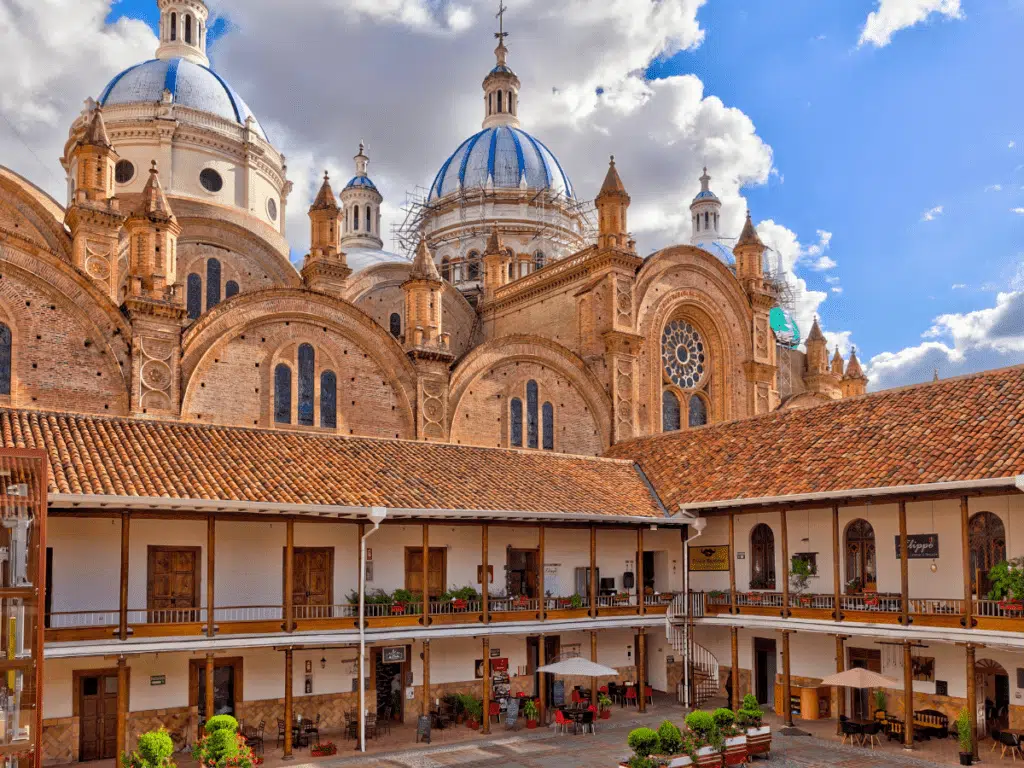
Cuenca, Ecuador
Cuenca is a genuinely beautiful small city in the center of the country that has been attracting foreigners and Ecuadorians alike for years. It is a great option for those that want a nearly perfect climate and a more relaxed atmosphere than you might find in Quito.
If you’re looking for a lot of city amenities but at a slower pace, I recommend checking out Cuenca.
Best Parts of Living in Cuenca
A Large Expat Community
There are A LOT of expats and retirees living in Cuenca, attracted to the city by its perfect climate and the lower cost of living relative to the United States and Europe.
This means there are plenty of things you might miss from home, like a strong cafe culture, people to meet who speak your own language, and plenty of new friends willing to help you get adjusted to life in Ecuador.
A Growing Digital Nomad Community
Cuenca has a smaller digital nomad community than Quito, but it is a growing one. There are several good options for coworking spaces that will help you get connected to the community and enjoy your stay.
Cuenca is Beautiful
Like Quito, Cuenca is a truly beautiful city in its own way. You’ll be able to enjoy beautiful views from every angle, and the historical center of the city is stunning.
Plus, Cuenca is near plenty of beautiful places to explore – national parks, nature reserves, and more (don’t miss Parque Nacional El Cajas).
Worst Parts of Living in Cuenca
A Lot of Foreigners = Higher Prices
A large number of foreigners, especially retirees, can be both an advantage and a disadvantage for living in Cuenca. It means that prices are higher for a lot of things, including housing when compared with Quito or other cities in Ecuador.
If you’re only spending time with other expats, too, you may miss out on some local experiences or opportunities to build other relationships, practice your Spanish, etc.
Smaller City Size
For those that crave a smaller community, Cuenca is perfect, but for those looking for more hustle and bustle, it may get boring after a while.
If you’re interested in networking with local business owners and companies in Ecuador, it would be much better to be based in Quito or Guayaquil than in Cuenca.
No International Airport
Cuenca is well connected to the rest of Ecuador by domestic flights and buses, but its airport only has flights to and from Quito. Another option is to travel by car or bus to Guayaquil, about 3.5 hours away, to catch a flight from this international airport.
If you’re looking to travel extensively, keep this in mind.
Read More About Travel to Ecuador
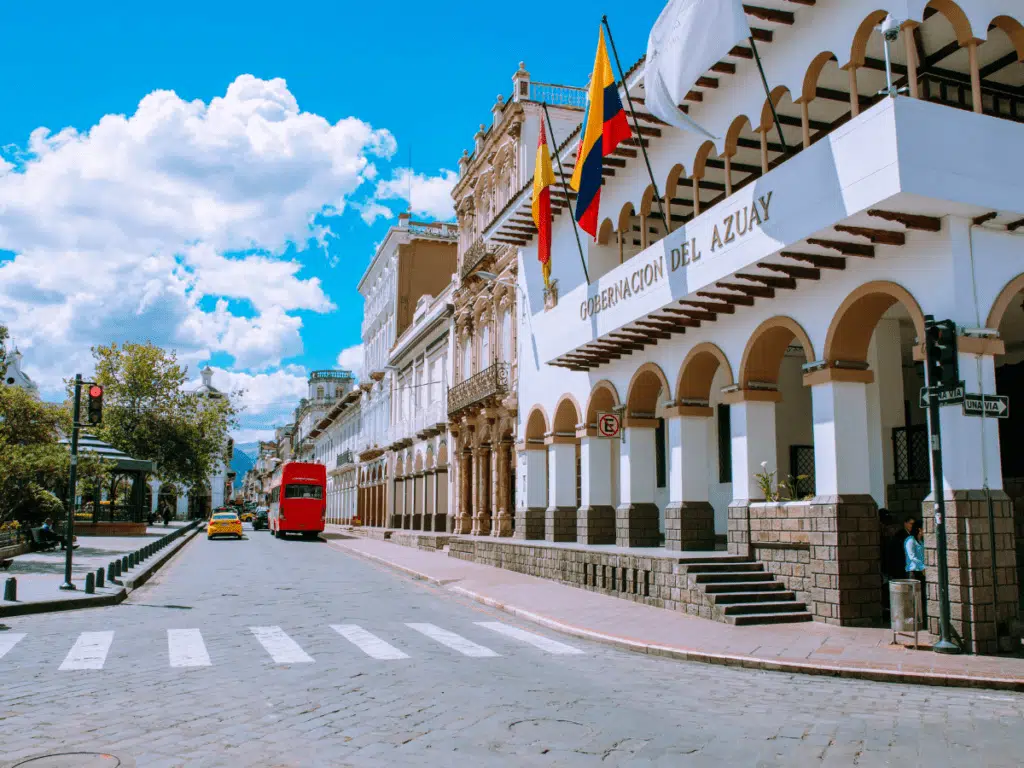
Cost of Living in Cuenca
Costs in Cuenca are slightly higher than they are in Quito for a few reasons, including a large number of expats and retirees driving prices up, and the smaller size of the city.
However, they still remain low compared with a lot of digital nomad hubs, and if you seek to be frugal can go even lower.
A digital nomad can live comfortably in Cuenca for $750-1100 per month.
Here are some typical monthly costs in Cuenca to consider:
– Rent: $500-775
– Coworking: $50-125
– Transportation: $30-40
– Groceries: $100-130
– Eating Out / Nightlife: $50-125
Coworking in Cuenca
For a city of less than half a million people, Cuenca has a good number of coworking spaces to choose from, thanks in part to the number of foreigners in Cuenca. Here are a few of the best worth considering.
Selina Coworking Cuenca
Experienced digital nomads in Latin America will recognize Selina as a group of digital nomad “hubs” that have locations throughout Latin America, now growing to Europe as well.
Selina Coworking locations are unique in that they offer both coworking spaces and accommodation options for digital nomads, plus tons of excursions and activities to foster community. Coworking spaces are also available for those who aren’t staying there.
The Selina Coworking Cuenca location is beautiful (think beautiful yet welcoming modern design) and well-located in the center of the city. It doesn’t have as many social events as other Selina sites do, but it is a fantastic coworking option in Cuenca.
Coworking membership plans start at $70 per month.
Travel Essential
Don’t think about traveling without a good VPN (Virtual Private Network). Using a VPN while connecting to the internet is an easy way to keep your personal information safe from hackers and trackers. We’ve used NordVPN for years and couldn’t recommend it more – it’s a must for safety online, at home or abroad.
Impaqto
One of our favorites from Quito, Impaqto also has a branch in Cuenca worth looking into when you’re here. It is quite new and still growing its profile in the city, but it’s very well located just blocks away from anything you could want to see and do.
Like the Impaqto locations in Quito, the space here is very well-designed and beautiful. Plans start at $100 per month.
Transportation in Cuenca
Local Transportation
The local bus system in Cuenca is extensive and covers a lot of ground, making it a very convenient and inexpensive way to get around – most rides are $0.25 or not much more.
However, like in the rest of Ecuador, they can get crowded. Hold on to your things well on crowded buses! Alternatur offers an interactive map of bus routes to help you map your journey.
Taxis are also common, as are ridesharing apps like Uber, and they are both relatively inexpensive options as well.
Regional Transportation
Ecuador is quite well connected with regional buses almost everywhere, and Cuenca is no exception. Cuenca’s bus station is called the Terminal Terrestre and offers regular buses to Quito, Guayaquil, Loja, Vilcabamba, Baños, and nearby destinations.
International Transportation
Cuenca’s airport is the Mariscal Lamar Airport – currently, it only operates flights to and from Quito (just under an hour-long flight). For international flights, you’ll need to connect through Quito, or find ground transport to Guayaquil – about 3.5 hours away – and fly from there.
Cuenca is near the border with Peru, and there are bus options that will take you to Peru. I found a blog post from 43 Blue Doors with an extensive guide to traveling from Cuenca to Peru by bus.
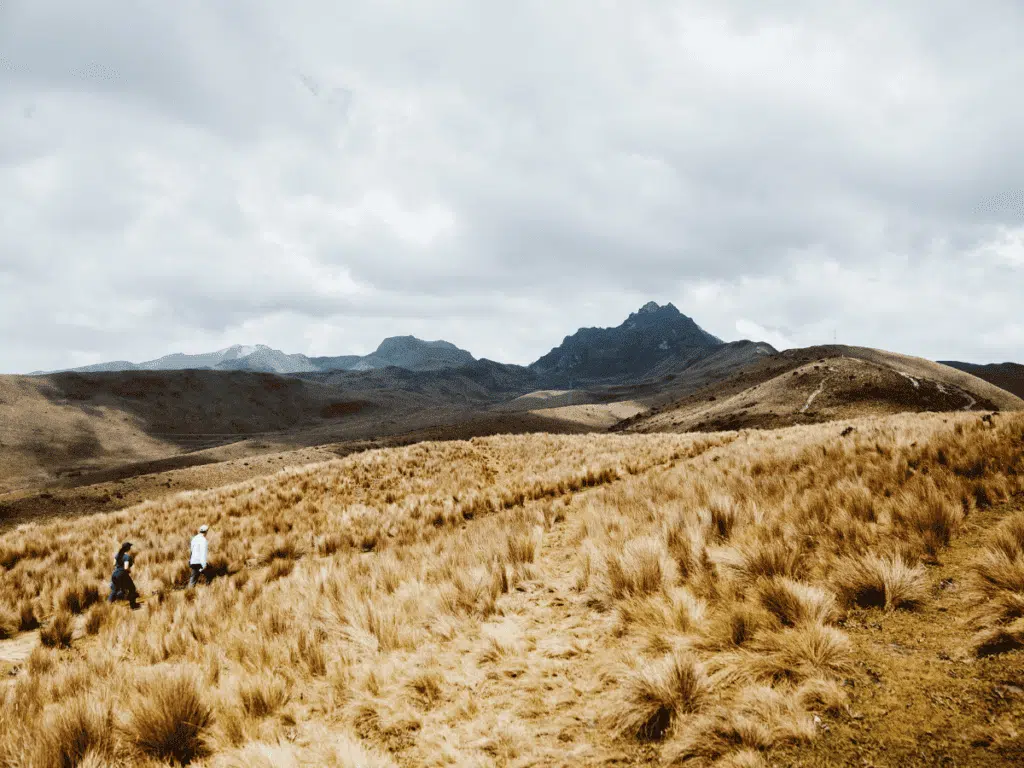
Things To Do in Cuenca
There is plenty to keep you busy and entertained in Cuenca, but here are just a few things that stick out as favorites – add them to your list!
- Visit Parque Nacional El Cajas (El Cajas National Park) for some incredible hiking and beautiful landscape. You’ll find routes for all levels of experience, and there are plenty of guided options available as well.
- Ecuador’s most elaborate Incan ruins are a short drive from Cuenca at Incapirca – while not as extensive as some you’ll find in the Sacred Valley in Cusco, these are incredible and worth a visit.
- Goza Espresso Bar is a great place for coffee and some delicious bites, in the center of Cuenca. Very cozy and the perfect place to meet other expats or digital nomads.
- Eat at the 9 de Octubre Market food stalls for delicious and inexpensive local food like roasted pork (hornado), sweet corn tamales (humitas), and much more. This is also the perfect place to stock up on fresh fruit and veg for the week.
- Thermal springs are common in the volcanic mountain region of Ecuador, so you won’t want to miss the Piedra de Agua complex to experience the naturally warm and healing waters – and they have spa treatments, too!
Additional Cities for Digital Nomads in Ecuador
The internet in Ecuador is now generally strong enough that you can work remotely from most places if you want to, which opens up more of the country to digital nomads looking to move around more often.
Cities that are popular with travelers and have lots to see and do but don’t have a digital nomad community are places you can set up for a week or two at a time and work from comfortably.
These are places I recommend if you’re traveling as a digital nomad.
Mindo
Mindo is a small town with just one main road – but it’s one of my favorite places in Ecuador. Surrounded by the cloud forest, this feels like a tiny paradise.
Come here for waterfall hikes, hummingbird watching, and zip-lining – to decompress and enjoy nature. Setting up in a cafe or at the lovely hostel Casa de Cecelia overlooking the forest is ultimate work goals.
Read More
- A Guide to Mindo: Ecuador’s Cloud Forest Paradise
- Activities in Mindo: The Best Things to do in the Cloud Forest
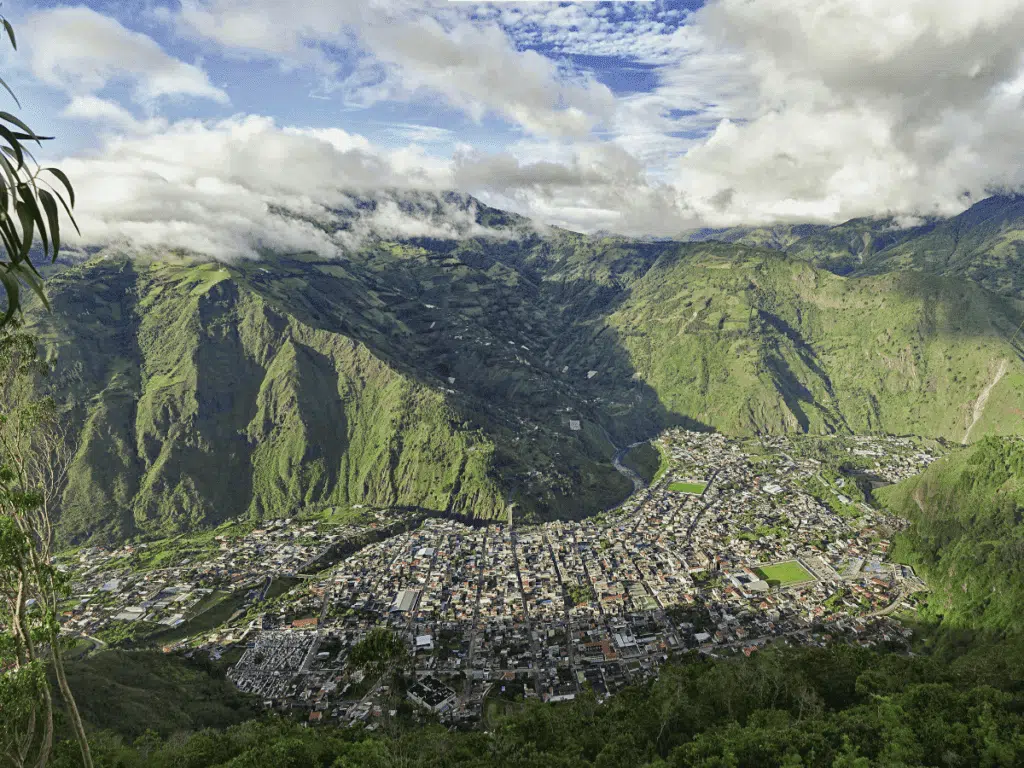
Baños
Baños is, like Mindo, a gem of nature, making it the perfect escape from the city. Much more built up than Mindo, there are plenty of cafes, restaurants, and accommodation options to choose from.
Top activities include whitewater rafting, mountain biking, bungee jumping, canyoning, and hiking.
Read More: Ultimate Travel Guide to Baños, Ecuador
Montañita
Montañita is a beach town best known for being a party town for backpackers – this is the place to be if you’re interested in enjoying the nightlife!
However, the town is relaxed during the day and the beach is fantastic. If you’d prefer a more laid-back beach town, check out Puerto López, Canoa, or Mompiche.
Otavalo
Best known to travelers for its incredible Saturday markets, which are famously the largest markets in all of South America, Otavalo is a small, largely-indigenous town towards the north of the country with plenty to do and see, like the nearby volcanic crater lake, Cuicocha.
The number of tourists the market attracts means there are some great restaurants and cafes here. I could easily work from the dreamy La Cosecha cafe for a month straight.
Read More: The Ultimate Guide to the Otavalo Market in Ecuador
Vilcabamba
This town is famed for its healthy living – there is a surprisingly high number of 100+ year-old residents – making it a place for health retreats, yoga, and generally a “crunchy” hippie vibe.
For being a town of only around 5,000 people, you’ll find a lot of expats here.
Guayaquil, Ecuador
Guayaquil is Ecuador’s largest city and financial capital and has its fair share of digital nomads and expats who work for Ecuadorian companies.
Despite being a large city and having big city amenities, Guayaquil is not as beautiful or appealing of a city as its mountainous counterparts. While I never felt unsafe there, it is generally considered less safe than Quito.
Guayaquil’s biggest appeal, at least in my opinion, is its proximity to the ocean, but with reliable internet in larger towns and cities along the coast, I recommend nomads looking for a coastal getaway look to choose a smaller city beachfront, like Salinas or Manta, or beachy towns like Montañita, Canoa, or Puerto López.
Read More: Guayaquil, Ecuador: Ultimate Travel Guide
Money-Saving Tips for Ecuador
Shop in Markets and Buy Local Food
With less than $10 a week, my husband and used to stock up on fruit and veg from a market down the street from our apartment and have more than enough to eat mostly plant-based meals.
This saved us a fortune. While shopping in supermarkets is appealing, try buying what you can in local markets – the cost-savings is huge.
Stick with locally-produced food as well – while peanut butter and bacon and bagels (though not together) may be calling your name, if you’re looking to stick to a budget try to cook with local products for big savings.
Avoid Import Tax
One downside of living in Ecuador is that the import tax makes purchasing things not produced in Ecuador quite expensive – especially when it comes to technology and brand-name items you may want from home.
It can sometimes be more cost-effective to travel to Peru or Colombia where the taxes are lower to purchase a new laptop or camera than it would be to purchase the same item in Ecuador.
If you’re looking to head to Ecuador as a digital nomad and your laptop or hard drive is on the fritz, it may be time to upgrade before leaving!
Looking to purchase a new laptop before your trip? Check out this guide to the best laptops for travelers before you make your purchase!
Use Facebook Groups and Facebook Marketplace
There are plenty of Facebook groups for buying and selling things in Ecuador where you can get some great deals on used items, clothes, furniture… anything.
We used a Facebook group called Leaving Quito Stuff Exchange to buy a lot of the things we needed from expats and students leaving Quito. Similar groups exist in many cities and can save you a lot of money.
Befriend Locals
Don’t underestimate how much having local friends will save you money. Making friends who will tell it to you straight, give pricing advice, and help you find the best way to get things done will make a world of difference.
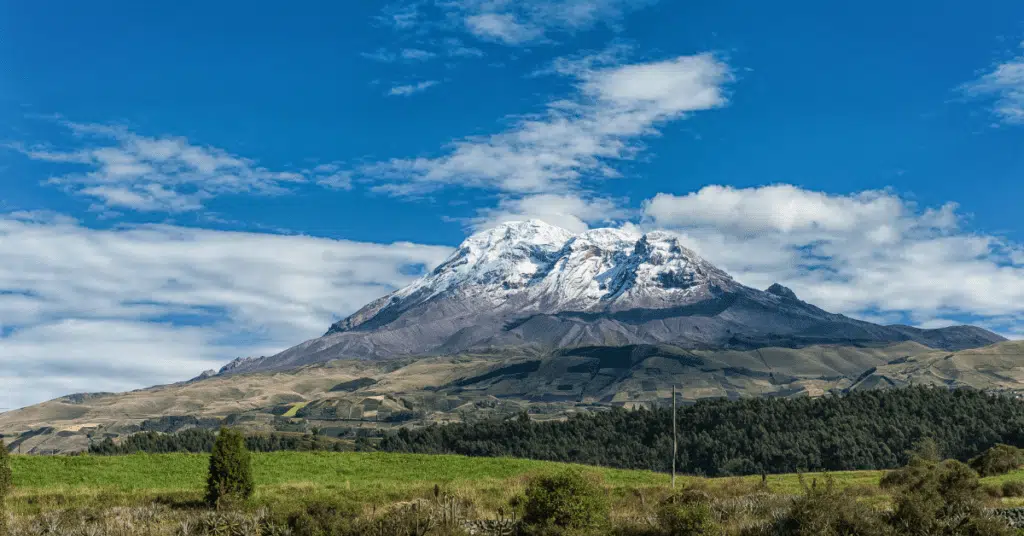
What to Pack for Moving to Ecuador
- A water filtration solution: I recommend bringing a SteriPen to filter tap water safely and easily, and a water bottle with a filter – I used both of these daily, and they’ll save you tons on bottled water.
- S-biners to keep your backpack and purse zippers locked shut to avoid pickpocketing. Get a padlock if you plan on using a hostel with a locker and and luggage locks for suitcases in hotels (probably overkill, but I do it anyways).
- A VPN service – so important to have for coworking or using internet in cafes where your information can easily be hacked. I have used and loved NordVPN.
- A rain jacket is a must
- Clothing to layer, and at least one warm jacket if you’re planning on visiting the mountain region (Quito, Cuenca, etc).
- Weather-ready shoes: my go to shoes were sneakers, flats, L.L. Bean Duck boots for the rainy season, and Chacos for hiking. Hiking boots are probably overkill unless you’re planning on climbing mountains.
- Sunscreen – it can be expensive in Ecuador, but is a necessity since you’re on the equator and at high elevation while in the mountains. Get reef safe sunscreen if you’re going to the beach.
- Kavu Rope Sling Bags are key for crowded areas, as you can pull them from behind you to in front without taking them off. They come in every color under the sun.
- Peanut butter and Sriracha (or your favorite treats from home you can’t usually find abroad)

Carley Rojas Avila is a bilingual New York-based travel writer, editor, content marketer, and the founder of the digital travel publications Explorers Away and Home to Havana. Carley is an expert on all things Latin America, the Caribbean, and Cuba, having lived and worked in four different countries in the region. Her writing has appeared on the Associated Press wires and in Travel + Leisure, Yahoo, MSN, Euronews, The Weather Channel, and more. When she's not writing about her travels, find her front row at a Bad Bunny concert, befriending street cats, and taste-testing every pizza in Havana.

